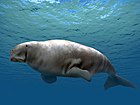
The Sirenia, commonly referred to as sea cows or sirenians, are an order of fully aquatic, herbivorous mammals that inhabit swamps, rivers, estuaries, marine wetlands, and coastal marine waters. The extant Sirenia comprise two distinct families: Dugongidae and Trichechidae with a total of four species. The Protosirenidae and Prorastomidae families are extinct. Sirenians are classified in the clade Paenungulata, alongside the elephants and the hyraxes, and evolved in the Eocene 50 million years ago (mya). The Dugongidae diverged from the Trichechidae in the late Eocene or early Oligocene.
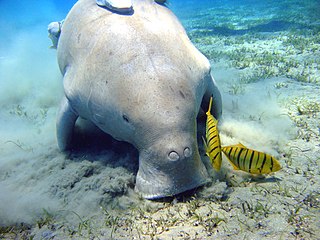
Dugongidae is a family in the order of Sirenia. The family has one surviving species, the dugong, one recently extinct species, Steller's sea cow, and a number of extinct genera known from fossil records.
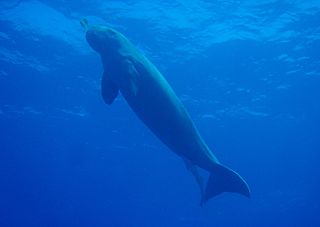
The dugong is a marine mammal. It is one of four living species of the order Sirenia, which also includes three species of manatees. It is the only living representative of the once-diverse family Dugongidae; its closest modern relative, Steller's sea cow, was hunted to extinction in the 18th century.

Hydrodamalis is a genus of extinct herbivorous sirenian marine mammals, and included the Steller's sea cow, the Cuesta sea cow, and the Takikawa sea cow. The fossil genus Dusisiren is regarded as the sister taxon of Hydrodamalis: together, the two genera form the dugong subfamily Hydrodamalinae. They were the largest member of the order Sirenia, whose only extant members are the dugong and the manatees. They reached up to 9 metres (30 ft) in length, making the Steller's sea cow among the largest mammals other than whales to have existed in the Holocene epoch. Steller's sea cow was first described by Georg Wilhelm Steller,

Halitherium is an extinct dugongid sea cow that arose in the late Eocene, then became extinct during the early Oligocene. Its fossils are common in European shales. Inside its flippers were finger bones that did not stick out. Halitherium also had the remnants of back legs, which did not show externally. However, it did have a basic femur, joined to a reduced pelvis. Halitherium also had elongated ribs, presumably to increase lung capacity to provide fine control of buoyancy. A 2014 review presented the opinion that the genus is dubious.
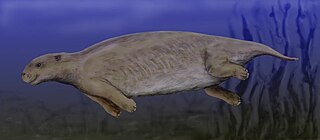
Prorastomus sirenoides is an extinct species of primitive sirenian that lived during the Eocene Epoch 40 million years ago in Jamaica.

Sirenia is the order of placental mammals which comprises modern "sea cows" and their extinct relatives. They are the only extant herbivorous marine mammals and the only group of herbivorous mammals to have become completely aquatic. Sirenians are thought to have a 50-million-year-old fossil record. They attained modest diversity during the Oligocene and Miocene, but have since declined as a result of climatic cooling, oceanographic changes, and human interference. Two genera and four species are extant: Trichechus, which includes the three species of manatee that live along the Atlantic coasts and in rivers and coastlines of the Americas and western Africa, and Dugong, which is found in the Indian and Pacific oceans.

Pezosiren portelli, also known as the "walking manatee", is a basal sirenian from the early Eocene of Jamaica, 50 million years ago. The type specimen is represented by a Jamaican fossil skeleton, described in 2001 by Daryl Domning, a marine mammal paleontologist at Howard University in Washington, DC. It is believed to have had a hippopotamus-like amphibious lifestyle, and is considered a transitional form between land and sea mammals.
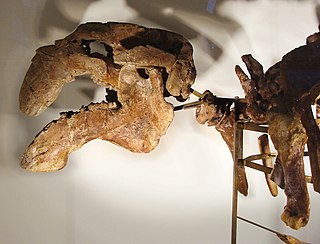
Eotheroides is an extinct genus of Eocene sirenian. It is an early member of the family Dugongidae, which includes the extant dugong. Fossils have been found from Egypt, India, and Madagascar. Eotheroides was first described by Richard Owen in 1875 under the name Eotherium, which was replaced by the current name in 1899.
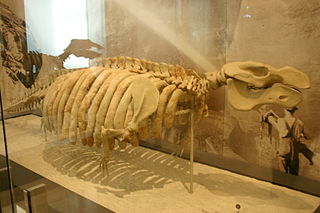
Metaxytherium is an extinct genus of dugong that lived from the Oligocene until the end of the Pliocene. Fossil remains have been found in Africa, Europe, North America and South America. Generally marine seagrass specialists, they inhabited the warm and shallow waters of the Paratethys, Mediterranean, Caribbean Sea and Pacific coastline. American species of Metaxytherium are considered to be ancestral to the North Pacific family Hydrodamalinae, which includes the giant Steller's Sea Cow.
Protosiren is an extinct early genus of the order Sirenia. Protosiren existed throughout the Lutetian to Priabonian stages of the Middle Eocene. Fossils have been found in the far-flung locations like the United States, Africa (Egypt), Europe and Asia.

Nanosiren garciae is an extinct sirenian dugong that lived in warm shallow seas in what is now Venezuela, approximately 11.610—3.6 Ma during the Miocene and Pliocene. The species is listed in the Paleobiology Database, funded by the Australian Research Council.

Prorastomidae is a family of extinct sirenians from Jamaica, related to the extant manatees and dugong. The family includes the oldest known fossils of Sirenians, represented in two genera:
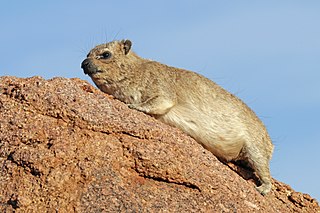
Hyraxes, also called dassies, are small, thickset, herbivorous mammals in the order Hyracoidea. Hyraxes are well-furred, rotund animals with short tails. Typically, they measure between 30 and 70 cm long and weigh between 2 and 5 kg. They are superficially similar to pikas and marmots, but are more closely related to elephants and sea cows.

Dusisiren is an extinct genus of dugong related to the Steller's sea cow that lived in the North Pacific during the Neogene.
Anomotherium is an extinct genus of manatee that lived in the shallow seas of what is now northern Germany. Its closest relative is Miosiren. Fossils of the genus have been found in the Bohlen and Doberg Formations of Germany.

The Cuesta sea cow is an extinct herbivorous marine mammal and is the direct ancestor of the Steller's sea cow. They reached up to 9 metres (30 ft) in length, making them among the biggest sirenians to have ever lived. They were first described in 1978 by Daryl Domning when fossils in California were unearthed. Its appearance and behavior are largely based on that of the well-documented Steller's sea cow, which, unlike the Cuesta sea cow, lived into modern times and was well-described.

Lentiarenium was an early sea cow from the Late Oligocene (Chattian) Linz-Melk Formation of Austria. Known since the mid 19th century, Lentiarenium was long considered to be a species of Halitherium until a 2016 analysis showed it to be distinct.
Italosiren is an extinct genus of early dugong from the Early Miocene (Aquitanian) Libano Formation in northern Italy.
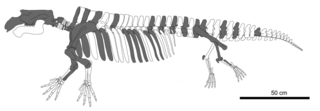
Sobrarbesiren is a genus of extinct sirenian that lived in the Eocene, about 47 million years ago. The type and only species is S. cardieli, known from a multitude of specimens from the Spanish Pyrenees. Sobrarbesiren was a medium-sized animal, 2.7 m long and still retaining both pairs of limbs. Although initially thought to be amphibious, later studies instead suggest that they would have been fully aquatic and been selective sea grass browsers. Unlike modern dugongs and manatees, they likely lacked a tail fluke, although it would have appeared horizontally flattened.


















